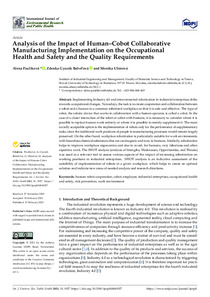Analysis of the impact of human-cobot collaborative manufacturing implementation on the occupational health and safety and the quality requirements

Pauliková, Alena ; Gyurák Babelová, Zdenka ; Ubárová, Monika
International Journal of Environmental Research and Public Health
2021
18
4
1-15
robots ; human-system interface ; risk management ; industrial production ; automation ; occupational safety
Occupational safety and health
https://doi.org/10.3390/ijerph18041927
English
Bibliogr.
"Implementing Industry 4.0 and interconnected robotization in industrial enterprises drifts towards occupational changes. Nowadays, the task is to create cooperation and collaboration between a robot and a human in a common robotized workplace so that it is safe and effective. The type of robot, the robotic device that works in collaboration with a human operator, is called a cobot. In the case of a closer interaction of the robot or cobot with humans, it is necessary to consider where it is possible to replace human work entirely or where it is possible to merely supplement it. The most socially acceptable option is the implementation of robots only for the performance of supplementary tasks, since the traditional work positions of people in manufacturing processes would remain largely preserved. On the other hand, workplace robotization is particularly suitable for work environments with hazardous chemical substances that are carcinogenic and toxic to humans. Similarly, robotization helps to improve workplace ergonomics and also to avoid, for humans, very laborious and often repetitive work. The SWOT analysis (analysis of Strengths, Weaknesses, Opportunities, and Threats) was used as a relevant tool to assess various aspects of the impact of increasing robotization on working positions in industrial enterprises. SWOT analysis is an indicative assessment of the suitability of implementation of robots in a given workplace, which helps to create an optimal solution and indicate new areas of needed analysis and research directions."
Digital
The ETUI is co-funded by the European Union. Views and opinions expressed are however those of the author(s) only and do not necessarily reflect those of the European Union or the ETUI.